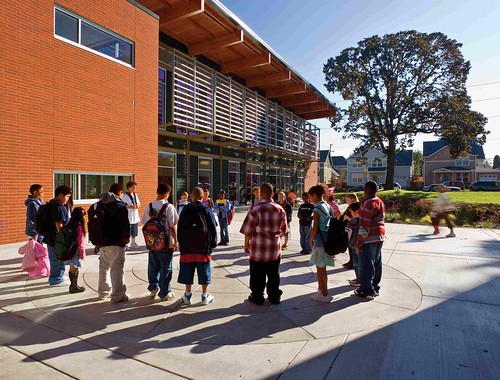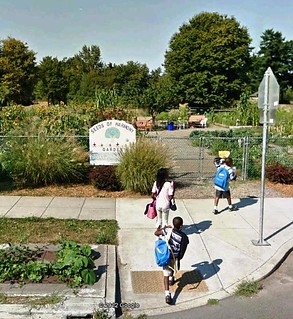Looking for a model of a walkable, green, community-serving school? Start here.

Posted July 20, 2012 at 1:35PM
Rosa Parks Elementary School in Portland, Oregon is housed in a super-green building that earned a LEED-gold certification and, according to the US Green Building Council, uses 24 percent less energy than a comparably sized but conventionally built school. About a third of its building materials were locally sourced, and virtually none of the construction waste went to a landfill. All stormwater is managed on site, none becoming polluted runoff.
But having a green building is only a small part of the story. Unlike so many new schools being built today, Rosa Parks sits right in the middle of a neighborhood where most of its students can and do walk or bike to school. A community garden is right across the street. Five large “heritage trees” were preserved on the 2.38-acre site, now a “community campus” also containing a Boys & Girls Club and neighborhood community center managed by the Portland Parks Department.
The website Architects of Achievement describes the school’s role in reviving a diverse and recently distressed neighborhood:
“The school is part of the largest revitalization project in Oregon history. Set on land donated by the Housing Authority of Portland, the K-5 school is part of the New Columbia Community Campus, which replaces the old crime-ridden Columbia Villa housing project. Serving as a model for educational improvement throughout the School District, this project was designed to serve the whole child, as well as the family, neighborhood, and greater community.”
Architectural Record adds:
“The new school is divided into four ‘neighborhoods,’ each containing 125 students. Each neighborhood contains five classrooms, a resource/student support room, and support functions around a ‘Neighborhood Commons.’ At the entry to the school, families are provided their own resource room, as well as access to a library information center. Functions including art, computers, music, and food service are shared with the new Boys & Girls Club.”
By all accounts, the school has been a great success and is now a source of much community pride and activity. Instead of relegating our kids to places where it has become illegal to walk to school, instead of schools plopped in the middle of nowhere, this is what we need more of – schools that anchor their neighborhoods, extending sustainability beyond their walls.
This video elaborates on these concepts better than I can. I love the beginning: “It wasn’t simply a school project. It was really a community project.”:
For a longer version that I like even better, go here.
Related posts:
- Will EPA's guidelines help communities build walkable schools? (October 18, 2011)
- Innovative East LA high school features urban planning and community engagement (November 19, 2010)
- Want to walk to school? Laguna Beach says nope, not here (October 19, 2010)
- The walk of life – helping Johnny (and Joanie) walk to school (March 31, 2010)
- Great principles for “smart growth schools” (June 29, 2009)
- A photo essay on school sprawl (part 2) (September 19, 2008)
- A photo essay on school sprawl (part 1) (September 18, 2008)
Move your cursor over the images for credit information.


